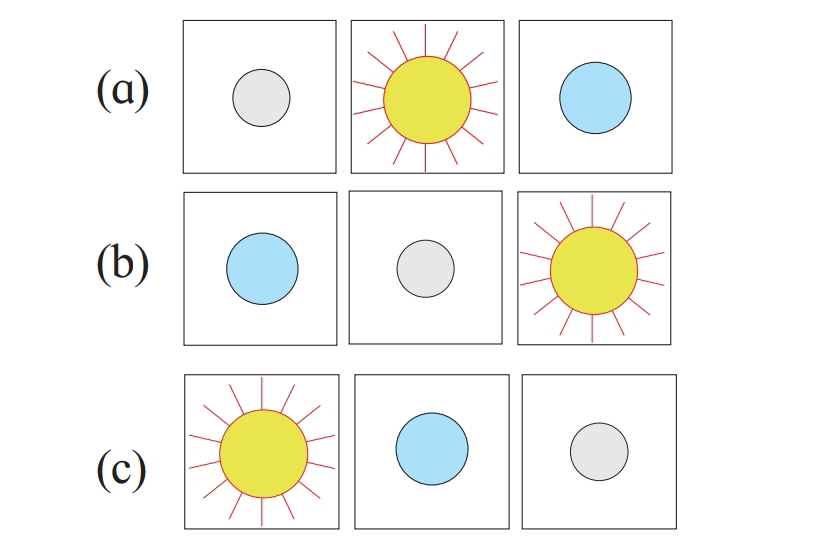Class 7: 2. The Sun, the Moon and the Earth
Class 7: 2. The Sun, the Moon and the Earth
Q. 1. Correct the wrong statements. Write down the corrected ones.
(1) The moon revolves around the sun. Ans: Wrong - The moon revolves around the earth.
(2) On a full moon day, the moon, the sun and the earth are positioned in this sequence.
Ans: Wrong – On a full moon day, the sun, the earth and the moon are positioned in this sequence.
(3) The revolutionary orbits of the earth and the moon is on the same plane. Ans: Wrong – The revolutionary orbits of the earth and the moon are not in the same plane. The moon’s revolutionary orbit makes an angle of about 5° with the earth.
(4) In one revolution of the moon, its orbit intersects the earth’s orbit only once.
Ans: Wrong – In one revolution of the moon, its orbit intersects the earth’s orbit twice.
(5) It is alright to observe a solar eclipse without protecting the eyes.
Ans:Wrong – It is necessary to view the sun disc through dark glasses or through special goggles made for that purpose, otherwise the intense light of the sun can be harmful to the naked eye.
(6) An annular solar eclipse occurs when the moon is in the perigee position.
Ans: Wrong – An annular solar eclipse occurs when the moon is in the apogee position.
Q. 2. Select the correct option.
(1) Solar eclipse
(2) The shape of the sun disc at the time of annular solar Eclipse.
(3) Apogee position of the moon.
Ans: (c)
Q. 3.Complete the following table.
Q. 4. Draw and label the diagrams.
(1) Total and partial solar eclipse.
(2) Total and partial lunar eclipse.
Q. 5. Answer the following.
(1) Why do the sun, the moon and the earth not lie in one and the same line on every full moon and new moon day? Answer: (i) The orbital path of the earth and that of the moon are not in the same plane.
(i ) The moon’s revolutionary orbit makes an angle of about 5° with that of the earth. (iii) On each new moon day, the lines joining the earth and the sun and the moon make an angle of 0° whereas on each full moon day, this angle is 180°.
(iv) So, the sun, the earth and the moon may not be in one straight line in the same plane on every new moon or full moon day.
(2) When total solar eclipse occurs why is partial eclipse also seen from the earth ? Answer: (i) On a new moon day if the sun, the moon & the earth fall in one line & are in the same plane, the shadow of the moon falls on the earth.
(ii) This shadow is of two types – the central portion of the shadow is darker & the periphery is light.
(iii) In the area where the dark shadow falls, the sun becomes completely invisible. Such an area experiences a total solar eclipse.
(iv) However during the same period, at the places where the shadow is lighter, the sun disc appears partially covered. Such an area experience partial solar eclipse. Thus when a total solar eclipse occurs a partial eclipse is also seen from the earth. (3) Suggest measures that can be taken to eradicate the superstitions related to the eclipses.
Answers: The following measures can be taken to eradicate superstition related to eclipses:
☐ Use of media to create awareness.
Parental guidance to help think logically.
☐ Teachers guidance to help students develop a scientific outlook.
☐ Campaigns, public meetings and lectures especially in rural areas to eradicate superstitions.
4.What precautions should we take while observing a solar eclipse?
Answer:
The precautions to be taken while observing a solar eclipse are:
We should not observe a solar eclipse with naked eyes as the intense light of the sun can harm them. We must use dark glasses or goggles that are specially designed for viewing the solar eclipse.
5.What types of Solar eclipses will occur in perigee conditions?
Answer: Total and Partial solar eclipse will occur in perigee condition.
(1) Total solar eclipse : On a new moon day, the sun, the moon the earth are in a straight line & the shadow of the moon falls on the earth The area of dark shadow falls on the earth, the sun becomes completely invisible. This condition is known as total solar eclipse.
(2) Partial solar eclipse: However during the same period at places where the shadow is lighter, the sun disc appears partially covered, This condition is described as partial solar eclipse.









Comments
Post a Comment